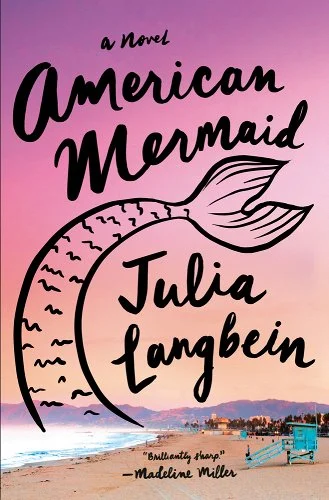[ad_1]
A decade ago, the success of wizard books and vampire franchises had caused something of a stir in literary New York. Culture writers Lindsay Weber and Amanda Dobbins declared in Vulture that “Mermaids are the New Vampires.” More than one literary agent even went as far as telling me they were seeking out a mermaid franchise. Julia Langbein’s debut novel American Mermaid is a clever way of getting there. The novel within a novel tells the story of a mermaid fighting to save the world from imminent destruction, framed in a narrative about the author of American Mermaid writing the film adaptation.
The narrative alternates between Penelope’s first person account of her experience in Los Angeles and excerpts from her novel featuring Sylvia, a mermaid discovered as a young girl and surgically altered to fit in among the humans. Penelope, who often goes by Penny throughout the novel, worked as a school teacher. Her debut novel was a smash hit and optioned for a film. However, she also has tested positive for a gene that ensures she’ll develop breast cancer, so she heads to California as a screenwriter in order to fund a double mastectomy.
Sylvia’s story begins when her billionaire father and infertile mother find an orphaned mermaid. Instead of returning her to the sea, they split her tail into two nonfunctioning legs. When she attempts suicide by drowning in the ocean, Sylvia’s tail temporarily heals and she discovers the secret kept from her. Masahiro, the doctor who performed the tail split surgery, confides in Sylvia that her father plans on melting the ice caps, and enlists her in a plan to stop the destruction of the planet.
There are many moving parts to this novel. The conflict Sylvia faces as a mermaid-turned-human could be seen as a reflection on non-binary people struggling to fit into the world. This reading seems particularly apropos once Penny reveals she identifies as asexual. Sylvia is also a person living with a physical disability, at least until Masahiro reveals his surgery has turned her into a Marvel-style superhero. This novel is set against the threat of global warming and also the threat of a billionaire super villain. It’s hard to know if this is a satire of a comic book movie or an accurate reflection of contemporary history.
The novel has made Penny a wild success, although her agent quickly reminds her success in the literary world is somewhat more limited than the success of Hollywood celebrities. She has a difficult relationship with her parents, not just because they paid for the genetic testing, but they refuse to pay for the elective surgery that would keep her cancer free. Her father is also a radical conservative who might seem like a satirical character if most of boomer-age America wasn’t also tied to ultra conservative conspiracy theories. Her asexuality is another thorn in the relationship with her father who incorrectly asserts she is “a new kind of gay.”
Penny continually finds herself attending exciting celebrity-fueled Hollywood parties where she inevitably encounters calamity. She nearly drowns at a beach party, shoots a rat with an air rifle, and even electrocutes herself on a fence intended to keep goats contained. These absurdist scenarios add a levity to her situation, which is growing more dire by the page. Her efforts to adapt the script into a tentpole superhero film are not going well.
The novel examines the creative process and the struggle to make art. Penny is technically a co-writer for the script. Unfortunately for her, Randy and Murphy keep trying to rewrite her novel with nonsensical plot points. In some respects, they aren’t wrong. They are making a film, a visual medium, and they point to parts of the book where a novel has strengths like interiority, but simply won’t work on screen. They want a Hollywood blockbuster; Penny wants to be true to her novel, her character, the mermaid. Mysteriously, changes are made to the master script. Penny blames a mystical spirit, her mermaid Sylvia. Randy and Murphy blame Penny’s drinking. Ultimately she achieves the best possible outcome: the film becomes bogged down in rewrites. Her novel may never be adapted, but at least it won’t become someone else’s vision of the book.
Sylvia and Penny mirror each other in many ways. When Sylvia enters the water and becomes a mermaid, she blacks out—as though becomes a different person. Similarly, Penny gets black out drunk and can’t recall if she is the one making the script changes. Penny’s asexuality means she, like Sylvia, doesn’t fit into society. Langbein finds a narrow space of ambiguity where we can wonder if they are in fact the same person and not just an author and her character.
If there is a weakness to the novel, it is the inclusion of so many disparate components. Langbein largely manages to contain the many threads into a coherent and entertaining narrative, but the book is filled with chaotic energy. Some threads, like Penny’s initial concern about raising money for a mastectomy, fade away once they become less useful to the plot. But largely, this chaos helps keep the book refreshing. The chapters are short, and swapping perspectives between Penny’s present and excerpts from her novel incentivize page turning. And the chaotic energy means there is no shortage of surprises and twists. The plot unfolds quickly, and the brief scenes often mean we as readers have little time to worry about whether everything works.
The mechanics of Sylvia’s transformation between humans and mermaid, for instance, are best not over analyzed. Or to harken back to the aughts wave of vampires, in True Blood, the vampire Bill Compton explains to human Sookie Stackhous that understanding how something works doesn’t make it less of a miracle. Langbein has written a sincere novel about art, Hollywood, sexuality, feminism, global warming, the cultural zeitgeist—and managed to do so while entertaining with a modern voice and a light touch of humor. American Mermaid might not be a blockbuster superhero film franchise, but it succeeds in telling a compelling narrative with many entry points for social critique.

FICTION
American Mermaid
By Julia Langbein
Double Day Books
Published March 21, 2023

[ad_2]
Source link

